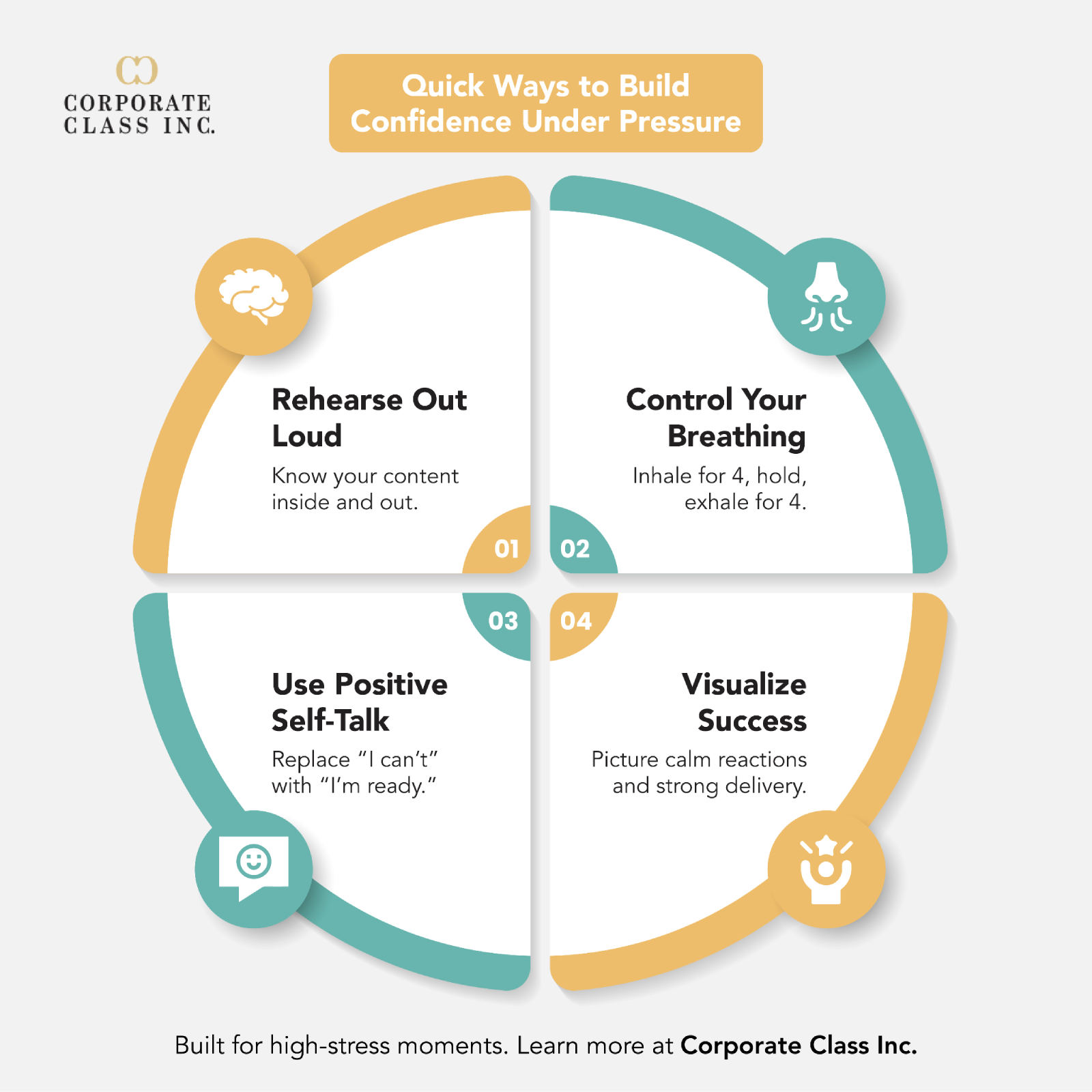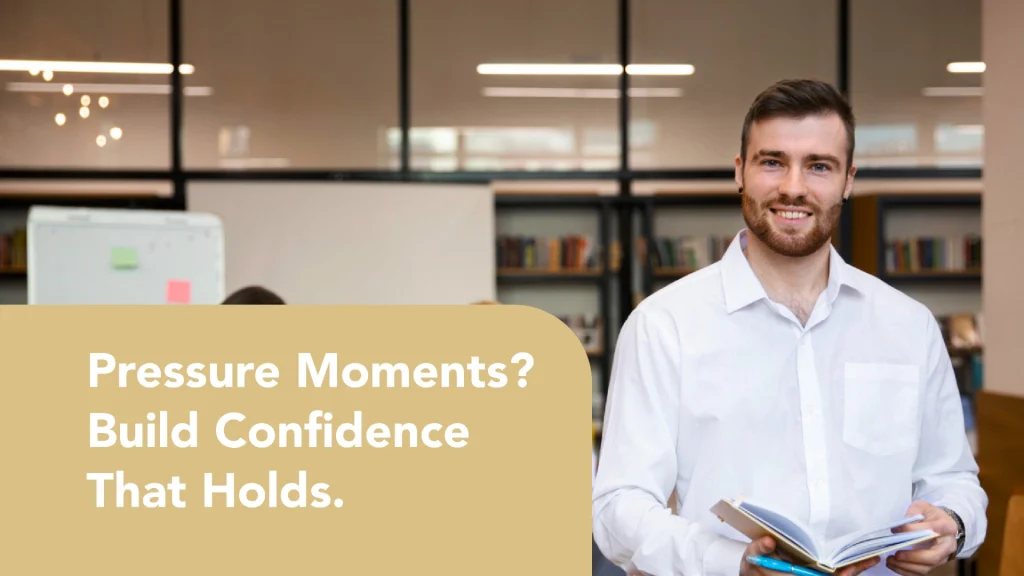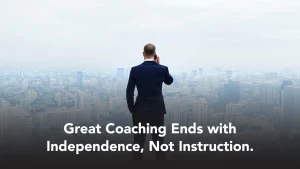You don’t have to feel fearless to be confident under pressure. What matters is how you respond when the stakes feel high. Whether you’re presenting to a group, navigating a tight deadline, or making a key decision, pressure will show up, and your confidence can too. Developing this skill doesn’t require perfection. It requires practice, structure, and a mindset that turns tension into focus.
This article walks you through the psychology of pressure and the strategies that help you respond with calm confidence. If you’re a student, a leader, or anyone working through demanding situations, these tools are built for you.
Key Takeaways:
- Confidence under pressure grows from preparation, not perfection. Know your material, control your breathing, and stay grounded in the process.
- Mindset matters: reframing your inner dialogue, accepting unpredictability, and viewing mistakes as learning points builds emotional stability.
- Support systems, positive routines, and visual rehearsal techniques give you reliable tools to stay steady during high-stakes moments.
Building Confidence Under Pressure Reframes Your Mindset
Pressure changes how your brain works. You might notice tunnel vision, faster heartbeats, or second-guessing yourself. These reactions are natural, but they don’t have to control you. Confidence under pressure isn’t about removing stress, it’s about learning to work alongside it.
By focusing on the things you can control, such as your preparation and mental framing, you create stability. With time, those shaky moments feel less intimidating and more manageable. This isn’t just good for performance, it supports your emotional well-being, too.
If you’re preparing for a high-stakes presentation or academic challenge, explore Corporate Class Inc.’s Presentation Skills Training to help you structure your delivery with clarity and confidence.
10 Ways to Build Confidence Under Pressure
Let’s break down the actions that strengthen your response to pressure. Each approach supports how you prepare, react, and recover in tense situations. You don’t need to use every method every time. Choose what fits your experience and build from there.
1. Thorough Preparation
Confidence starts before the pressure begins. When you know your material or responsibilities inside out, it’s easier to stay composed when tension rises. Preparation reduces surprises and gives you structure to fall back on.
- Review your notes and rehearse aloud. Don’t just read silently, speaking helps you internalize information. Use real-world phrasing, not memorized scripts.
- Create outlines or checklists to organize your thoughts. Break your tasks into smaller parts so they feel manageable. Structure leads to clarity, which builds control.
- Plan your timing if you’re facing a time-sensitive task. Practice pacing through sections. Build in breathing space for review and unexpected hiccups.
2. Mental Flexibility and Acceptance
Rigid expectations can add more stress. Mental flexibility means you stay grounded even when plans shift. Flexibility also allows you to redirect your attention when things don’t unfold as you imagined.
- Acknowledge that things might not go exactly as planned. Predicting hiccups reduces their emotional impact.
- Prepare for alternative outcomes without getting stuck on them. Create two or three quick backup responses in case something shifts.
- Focus on the effort, not just the finish line. Growth happens in the middle, not just at the end.
3. Positive Self-Talk and Reframing
The way you speak to yourself under pressure matters. If your inner voice is critical, your body responds with tension. Positive self-talk redirects your focus toward action and helps you stay present.
- Replace “I can’t handle this” with “I’m doing the best I can.” Speak to yourself the way a supportive coach would.
- Remind yourself of times you’ve succeeded under pressure. Keep a mental bank of wins. Bring one to mind when doubt creeps in.
- Avoid exaggerated language like “this must be perfect.” High standards are good, but absolute thinking limits your flexibility.
4. Visualization Techniques
Before a stressful moment, picture yourself succeeding. This mental rehearsal strengthens confidence and familiarity. It trains your brain to respond in calmer, clearer ways.
- Close your eyes and walk through the situation mentally. Picture the space, sounds, and your own movements.
- Imagine steady breathing, calm reactions, and clear speaking. Visuals work best when they include sensory details.
- Try this regularly before exams, interviews, or speeches. It becomes easier the more you practice.
5. Controlled Breathing
Shallow breathing can increase stress. Deep, steady breathing calms your nervous system and re-centers your attention. It also gives you a moment to regroup before responding.
- Try box breathing: inhale for 4 seconds, hold for 4, exhale for 4. Repeat until your body relaxes.
- Use breathing as your first tool when panic rises. You don’t need anything else, just a few seconds of focus.
- Combine breathing with a grounding phrase, like “I’m ready” or “I’ve got this.” This anchors your mind as your body calms.
● Improve how you think, speak, and present in pressure-filled environments
6. Focus on the Process, Not the Outcome
When the outcome feels uncertain, shift your focus to the steps in front of you. This reduces anxiety and builds control. The process is where your influence lives.
- Concentrate on doing one step at a time. Trying to leap to the finish line creates pressure.
- Let the process become your goal. Each action builds momentum and confidence.
- Use routines to make this easier (e.g., same setup for every test or presentation). Routines reduce decision-making fatigue.
7. Accept Mistakes as Learning Opportunities
Mistakes under pressure feel bigger than they are. Instead of spiraling, use them to get better next time. Acceptance doesn’t mean lowering your expectations, it means treating errors as feedback.
- Notice what went wrong without blaming yourself. This removes shame and helps you stay objective.
- Ask, “What can I learn from this experience?” Then write it down or speak it aloud.
- Create a plan to adjust going forward. One small change is often enough to shift outcomes.
8. Confident Body Language
The way you stand, sit, and move shapes how you feel. Even small posture adjustments can support confidence under pressure. Your body leads, your thoughts follow.
- Keep your shoulders back and chin level. This opens your chest and helps with breathing.
- Make eye contact when speaking. It strengthens connection and signals clarity.
- Use purposeful gestures and avoid fidgeting. Controlled movement reflects presence.
9. Seek Support
Pressure doesn’t mean you have to go it alone. Having someone to talk through stress can ease the load and bring clarity. Support reinforces your belief that progress is possible.
- Talk to a mentor, coach, or trusted peer. They can offer perspective and share tools that helped them.
- Ask for feedback when you feel unsure. Good feedback helps you recalibrate.
- Use Corporate Class Inc.’s coaching resources to build a strong support network.
10. Create a Positive Mindset
A positive mindset doesn’t ignore the pressure, it invites growth through it. Seeing pressure as a chance to practice builds resilience. Confidence grows stronger in environments that challenge it.
- Focus on what’s going well, not just the challenges. Balance the inner narrative.
- Keep a journal of your wins and progress. Tracking helps your brain recognize improvement.
- Practice gratitude, especially after stressful experiences. Gratitude grounds you in perspective.

FAQ
What if I blank out in the middle of a presentation?
Pause, breathe, and return to your structure. You can even acknowledge it with a calm statement like, “Let me regroup my thoughts.” This keeps the momentum going without drawing negative attention. If needed, refer to a note or prompt to re-anchor your direction.
How long does it take to build pressure confidence?
It depends on the situation and your experience. Most people notice progress after a few consistent practices. Start small and build. Think of it as a skill you revisit regularly, progress isn’t always linear, but it’s trackable. Over time, your reactions become more measured and composed.
Can confidence under pressure be taught?
Yes. With support, feedback, and the right strategies, anyone can improve their ability to handle high-pressure situations. It’s about practice, not personality. The more you work with tools like breathing or reframing, the more natural they feel.
Mastering Confidence Under Pressure When it Matters Most
Confidence under pressure doesn’t appear out of thin air. It’s developed through preparation, reflection, and smart habits. The more you train your mind and body to respond with control, the more steady you’ll feel, no matter the challenge.
You’ll never eliminate pressure. That’s not the goal. The real win is feeling capable within it. With strategies like controlled breathing, reframing, and posture awareness, confidence under pressure becomes a skill you can rely on when it counts most.
Want to improve how you lead, speak, or handle pressure in your day-to-day life? Connect with a coach today to get started.
Learn with expert trainers who support students and professionals alike





